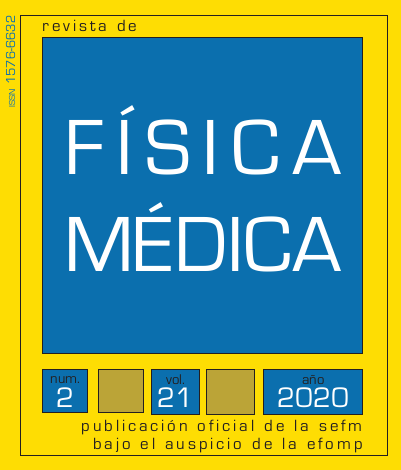Estudio de la emisión de radiación de frenado mediante simulaciones mixtas con el código Monte Carlo PENELOPE
DOI:
https://doi.org/10.37004/sefm/2020.21.2.002Palabras clave:
Bremsstrahlung, Simulaciones mixtas, Monte Carlo, PENELOPEResumen
El método Monte Carlo permite la descripción precisa de las propiedades de la radiación de frenado, la cual se emplea en medicina para radiodiagnóstico o radioterapia. El código PENELOPE descansa en la implementación de historias condensadas para el transporte de partículas cargadas y permite al usuario adaptar el grado de detalle de las simulaciones mediante los parámetros de simulación. La variación de estos parámetros puede afectar a las distribuciones de partículas obtenidas al simular radiación de frenado producida en blancos gruesos.
En este trabajo se analizan las diferencias entre simulaciones con distinto grado de detalle mediante la reproducción con PENELOPE de experimentos publicados de producción de radiación de frenado con electrones de alta y baja energía. Para ello se varían los parámetros de simulación C1 y C2 hasta alcanzar un valor a partir del cual los resultados de las simulaciones son estadísticamente equivalentes.
Se ha observado que una inadecuada elección de los parámetros de simulación conlleva una reproducción inexacta de las características del haz de frenado. Se necesita mayor grado de detalle para simular electrones de alta energía en un material de alto número atómico que para electrones de baja energía en un material de bajo número atómico.
Referencias
Baró J, Sempau J, Fernández-Varea JM, Salvat F. An algorithm for Monte Carlo simulation of the penetration and energy loss of electrons and positrons in matter. Nucl Instr and Meth in Phys Res B 1995;100:31-46.
Faddegon BA, Asai M, Perl J, Ross C, Sempau J, Tinslay J, Salvat F. Benchmarking of Monte Carlo simulation of bremsstrahlung from thick targets at radiotherapy energies. Med Phys 2008;35:4308-17.
Rodriguez M, Sempau J, Brualla L. Technical Note: Study of the electron transport parameters used in PENELOPE for the Monte Carlo simulation of Linac targets. Med Phys 2015;42:2877-81.
Pandola L, Andenna C, Caccia B. Validation of the Geant4 simulation of bremsstrahlung from thick targets below 3 MeV. Nucl Instr and Meth in Phys Res B 2015;350:41-8.
DeMarco JJ, Solberg TD, Wallace RE, Smathers JB. A verification of the Monte Carlo code MCNP for thick target bremsstrahlung calculations. Med Phys 1995;22:11-6.
Salvat F, Fernández-Varea JM, Sempau J, Llovet X. Monte Carlo simulation of bremsstrahlung emission by electrons. Radiat Phys Chem 2006;75:1201-19.
Seltzer SM, Berger MJ. Bremsstrahlung spectra from electron interactions with screened atomic nuclei and orbital electrons. Nucl Instr and Meth in Phys Res B 1985;12:95-134.
Seltzer SM, Berger MJ. Bremsstrahlung energy spectra from electrons with kinetic energy 1 keV-10 GeV incident on screened nuclei and orbital electrons of neutral atoms with Z=1-100. Atom Data Nucl Data 1986;35:345-418.
Kissel L, Quarles CA, Pratt RH. Shape functions for atomicfield bremsstrahlung from electrons of kinetic energy 1-500 keV on selected neutral atoms 1 ≤ Z ≤ 92. Atom Data Nucl Data 1983;28:381-460.
ICRU Report 77. Elastic scattering of electrons and positrons. Journal of the International Commission on Radiation Units and Measurements 2007;7:1-162.
Salvat F. PENELOPE-2014: A Code System for Monte Carlo Simulation of Electron and Photon Transport. OECD Nuclear Energy Agency, Issy-les-Moulineaux, France, 2015.
Faddegon BA, Ross CK, Rogers DWO. Forward-directed bremsstrahlung of 10-30 MeV electrons incident on thick targets of Al and Pb. Med Phys 1990;17:773-85.
Faddegon BA, Ross CK, Rogers DWO. Angular distributions of bremsstrahlung from 15 MeV electrons incident on thick targets of Be, Al and Pb. Med Phys 1991;18:727-39.
Rester DH, Dance WE, Derrickson JH. Thick target Bremsstrahlung Produced by electron bombardment of Targets of Be, Sn and Au in the energy range 0.2-2.8 MeV. J Appl Phys 1970;41:2682-92.
Dance WE, Rester DH, Farmer BJ, Johnson JH. Bremsstrahlung produced in thick aluminium and iron targets by 0.5 to 2.8 MeV electrons. J Appl Phys 1968;39:2881-9.
González W, Lallena AM, Alfonso R. Monte Carlo simulation of the dynamic micro-multileaf collimator of a LINAC Elekta Precise using PENELOPE. Phys Med Biol 2011;56:3417-31.
Sempau J, Badal A, Brualla L. A PENELOPE-based system for the automated Monte Carlo simulation of clinacs and voxelized geometries-application to far-from-axis fields. Med Phys 2011;38:5887-95.
Gallardo S, Querol A, Pozuelo F, Verdú G, Ródenas J. Application of the Monte Carlo codes PENELOPE and MCNP5 to unfold X-ray spectra in the diagnostic energy range. Radiat Phys Chem 2014;95:166-9.








